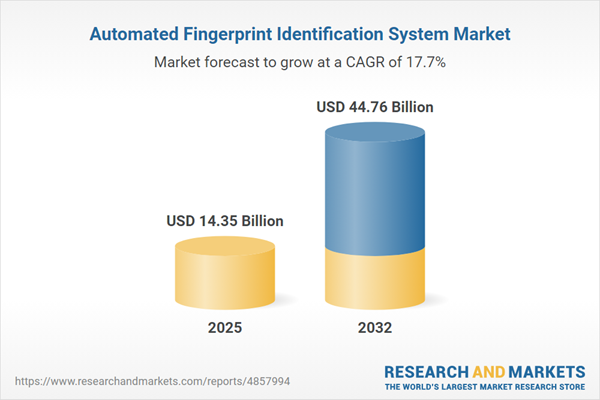Speak directly to the analyst to clarify any post sales queries you may have.
Automated fingerprint identification systems are transforming identity verification for organizations facing heightened compliance expectations and complex digital operations. As demands for reliable authentication and operational efficiency increase, adopting robust AFIS solutions delivers measurable benefits across sectors and regions.
Market Snapshot: Automated Fingerprint Identification System (AFIS) Market Growth
The Automated Fingerprint Identification System market is demonstrating robust expansion, driven by increasing global investments in digital security and compliance. In 2024, the market was valued at USD 12.17 billion and is projected to reach USD 14.35 billion by 2025, with an anticipated value of USD 44.76 billion by 2032, sustained by a CAGR of 17.67%. This growth trajectory reflects rapid adoption across government, finance, healthcare, and transportation as regulatory obligations rise and organizations seek solutions to strengthen risk management and streamline identity processes. Decision-makers are responding to these challenges by integrating advanced biometric authentication systems into critical workflows.
Scope & Segmentation
- Technology: 2D imaging is widely implemented in environments prioritizing speed and lower cost, while 3D fingerprint capture is selected for specialized scenarios requiring increased depth, accuracy, and precision in identification.
- Component: Hardware options include capacitive sensors for reliability, optical sensors for high-clarity image capture, and thermal sensors capable of functioning in challenging environments. Services comprise consulting—guiding end users through compliance and implementation—and maintenance support that ensures system uptime. Software targets identification workflows and provides middleware for integrating biometrics with broader IT infrastructure.
- End User: Banking and finance, defense, government, healthcare, and transportation leaders rely on AFIS to secure facilities, ensure regulatory compliance, and enhance public safety initiatives.
- Application: Use cases span critical access control, border security management, civil identification for public services, and investigative support within criminal justice and law enforcement.
- Geographic Focus: AFIS deployment is visible in the Americas, Europe, the Middle East, Africa, and Asia-Pacific, adapting to unique regional priorities such as public safety, digital modernization, and national identification programs.
- Key Companies: Leading market players include NEC Corporation, IDEMIA Public Security SAS, Thales S.A., Fujitsu Limited, BAE Systems plc, HID Global Corporation, Dermalog Identification Systems GmbH, Suprema Inc., Aware, Inc., and Daon, Inc.
Key Takeaways: Strategic Imperatives for Senior Decision-Makers
- Automated fingerprint identification accelerates identity authentication and reduces operational bottlenecks by automating verification in banking, border management, and healthcare settings.
- Recent advances in deep learning and sensor technologies enable high-level pattern recognition and secure mobile fingerprinting in field operations.
- Integration with cloud and edge analytics supports rapid identification and real-time database management, delivering operational agility.
- Compliance with data privacy directives is a purchase driver, with embedded encryption and anonymization essential for adherence to regulatory standards.
- AFIS adoption in emerging markets is closing persistent identity gaps, improving public service delivery and national criminal justice processes.
- Competitive trends show a shift to modular and mobile-ready solutions, enabling hardware and software provider collaboration for maximum scalability and flexibility.
Tariff Impact: Changes in Supply Chain and Market Access
The 2025 introduction of new United States tariffs has impacted both hardware and software segments of the AFIS market. Sensor manufacturers are adjusting by diversifying supply chains, increasing reliance on localized production, and sourcing alternatives to manage disruptions. In parallel, software integrators are optimizing development cycles by embracing open-source frameworks, which helps maintain competitiveness in cost-sensitive application areas. These adjustments underline a sector-wide movement toward supply chain transparency and innovation in sensor design, ensuring sustained delivery and adaptability amid shifting global trade policies.
Methodology & Data Sources
This research is grounded in a comprehensive approach, combining in-depth secondary analysis, structured interviews with experienced industry leaders, and the quantitative review of validated market datasets. Analytical rigor is maintained using scenario modeling and peer review, with strong adherence to ethical standards and data privacy guidelines throughout the research process.
Why This Report Matters for Senior Decision-Makers
- Delivers actionable insight on market trends, regulatory drivers, and technology evolution to guide strategic procurement and deployment of future-ready AFIS systems.
- Provides leadership with detailed analysis of supply chain shifts and tariff implications to support informed investment and risk management decisions across global operations.
- Supports the development of scalable, secure identity solutions for banking, government, healthcare, and defense in regulated environments.
Conclusion
Senior leaders navigating evolving security protocols and compliance directives gain tangible value from advanced AFIS solutions. This report empowers decision-makers to manage identity risk and support secure digital transformation across all user sectors.
Additional Product Information:
- Purchase of this report includes 1 year online access with quarterly updates.
- This report can be updated on request. Please contact our Customer Experience team using the Ask a Question widget on our website.
Table of Contents
3. Executive Summary
4. Market Overview
7. Cumulative Impact of Artificial Intelligence 2025
List of Figures
Samples

LOADING...
Companies Mentioned
The key companies profiled in this Automated Fingerprint Identification System market report include:- NEC Corporation
- IDEMIA Public Security SAS
- Thales S.A.
- Fujitsu Limited
- BAE Systems plc
- HID Global Corporation
- Dermalog Identification Systems GmbH
- Suprema Inc.
- Aware, Inc.
- Daon, Inc.
Table Information
| Report Attribute | Details |
|---|---|
| No. of Pages | 182 |
| Published | October 2025 |
| Forecast Period | 2025 - 2032 |
| Estimated Market Value ( USD | $ 14.35 Billion |
| Forecasted Market Value ( USD | $ 44.76 Billion |
| Compound Annual Growth Rate | 17.6% |
| Regions Covered | Global |
| No. of Companies Mentioned | 10 |









